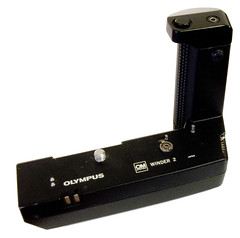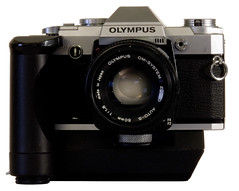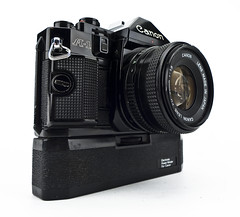Difference between revisions of "Film advance"
(added Calypso) |
m (missing image replaced) |
||
| Line 11: | Line 11: | ||
{{Flickr_image | {{Flickr_image | ||
| − | |image_source= http://www.flickr.com/photos/89864432@N00/1468985611/in/pool- | + | |image_source= http://www.flickr.com/photos/89864432@N00/1468985611/in/pool-camerawiki |
|image= http://farm2.static.flickr.com/1029/1468985611_1864f2774e_m.jpg | |image= http://farm2.static.flickr.com/1029/1468985611_1864f2774e_m.jpg | ||
|image_align= right | |image_align= right | ||
| Line 19: | Line 19: | ||
A few plate cameras - ''[[magazine camera]]s'' - (e.g. the [[Klito|Houghton Klito No.1]]) adopted a "falling plate" arrangement, where a number of plates were kept in a sprung magazine, usually behind the focal plane. After exposure, the exposed plate fell forward and down into a well, allowing the next one to move forward for use. | A few plate cameras - ''[[magazine camera]]s'' - (e.g. the [[Klito|Houghton Klito No.1]]) adopted a "falling plate" arrangement, where a number of plates were kept in a sprung magazine, usually behind the focal plane. After exposure, the exposed plate fell forward and down into a well, allowing the next one to move forward for use. | ||
| − | A related system had a magazine of plates, but a sliding mechanism to move them to the [[Focal_plane#Focal_Plane|focal plane]] and back. | + | A related system had a magazine of plates, but a sliding mechanism to move them to the [[Focal_plane#Focal_Plane|focal plane]] and back. This was eventually evolved into the [[Polaroid]] system of keeping a stack of film, exposing the top and then ejecting it. |
===Motor Drive=== | ===Motor Drive=== | ||
Many cameras - particularly later ones - have some form of automated wind-on, triggered by the [[shutter release]]. These use a clockwork mechanism (e.g. the [[Robot]] cameras or the [[Kodak Instamatic X-45]]; see [[:Category:Spring motor]]), or an electric motor. On a number of [[SLR]] systems, there were add-on motor-wind devices (''motor drives'') produced between the 1960s and 1990s. | Many cameras - particularly later ones - have some form of automated wind-on, triggered by the [[shutter release]]. These use a clockwork mechanism (e.g. the [[Robot]] cameras or the [[Kodak Instamatic X-45]]; see [[:Category:Spring motor]]), or an electric motor. On a number of [[SLR]] systems, there were add-on motor-wind devices (''motor drives'') produced between the 1960s and 1990s. | ||
| Line 37: | Line 37: | ||
}} | }} | ||
|{{Flickr_image | |{{Flickr_image | ||
| − | |image_source= http://www.flickr.com/photos/ | + | |image_source= http://www.flickr.com/photos/chrizzle/3475193188/in/pool-camerawiki |
| − | |image= http://farm4.static.flickr.com/ | + | |image= http://farm4.static.flickr.com/3349/3475193188_2019fd4ce5_m.jpg |
|image_align= right | |image_align= right | ||
| − | |image_text= [[Canon A-1]] with Winder | + | |image_text= [[Canon A-1]] with Winder <br /><small>by Christopher Robin Roberts {{with permission}}</small> |
}} | }} | ||
|} | |} | ||
[[category: Camera parts]] | [[category: Camera parts]] | ||
Revision as of 05:03, 8 February 2011
Film advance is a mechanism for moving film from one spool to another incrementally one frame at a time.
Advance may be a manual process, and may be called winding, advance, wind-on and various other terms, and may use, for example, a knob, key, lever, slider or thumbwheel. For this method there must be some way of stopping winding when the next frame is reached; typical methods are the red window, or some more positive method where the camera has a roller or sprockets measuring the film to stop the winding at the correct point - or the film has a single hole locating the frame, as in 110 and 126 cartridge films.
Some cameras uses more eccentric methods, such as the Werra and Agimatic, which has a ring around the lens for winding and the Voskhod has a lever rotating around the lens, or the Bencini Unimatic, where the shutter release button is pushed sideways to wind, and the Voigtländer Vitessa and Welta Penti - equipped with plungers. The Calypso uses the wind-on lever for releasing the shutter as well.
In many cameras, the film advance process also cocks the shutter, and, frequently, releasing the shutter unlocks the film advance - providing double-exposure protection.

|
| falling plate mechanism of the Conley Quick Shot |
Falling Plate
A few plate cameras - magazine cameras - (e.g. the Houghton Klito No.1) adopted a "falling plate" arrangement, where a number of plates were kept in a sprung magazine, usually behind the focal plane. After exposure, the exposed plate fell forward and down into a well, allowing the next one to move forward for use.
A related system had a magazine of plates, but a sliding mechanism to move them to the focal plane and back. This was eventually evolved into the Polaroid system of keeping a stack of film, exposing the top and then ejecting it.
Motor Drive
Many cameras - particularly later ones - have some form of automated wind-on, triggered by the shutter release. These use a clockwork mechanism (e.g. the Robot cameras or the Kodak Instamatic X-45; see Category:Spring motor), or an electric motor. On a number of SLR systems, there were add-on motor-wind devices (motor drives) produced between the 1960s and 1990s.
|
|
|


